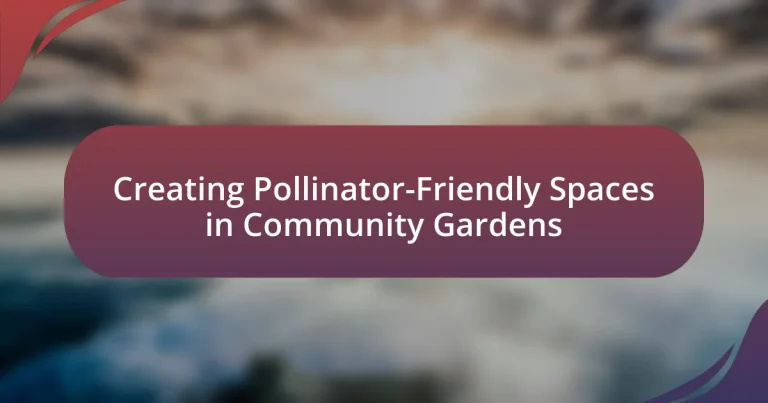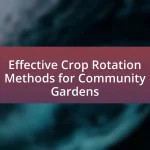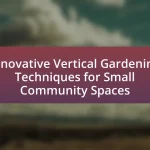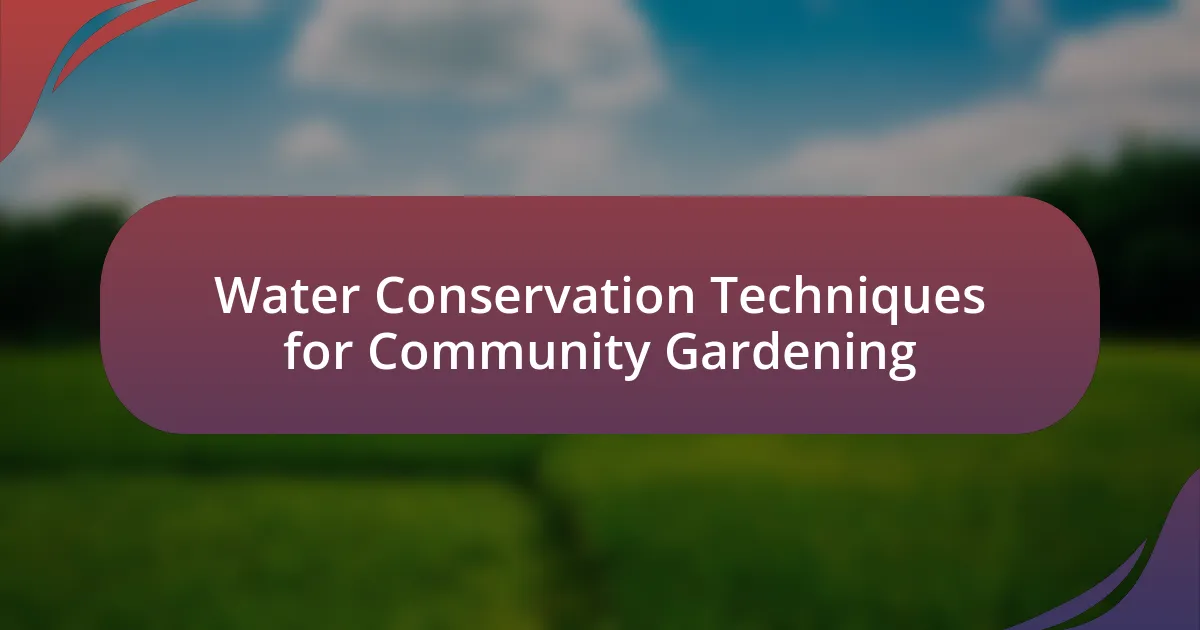Pollinator-friendly spaces in community gardens are essential areas designed to support pollinators such as bees and butterflies by providing habitats and resources. These spaces typically feature a variety of native flowering plants that bloom throughout the growing season, enhancing biodiversity and ecosystem health. The article explores the importance of pollinators in community gardens, their roles in food production, and the characteristics that define pollinator-friendly environments. It also addresses the challenges pollinators face in urban settings, offers design principles for creating supportive habitats, and highlights the significance of community involvement in maintaining these spaces. Additionally, practical tips for gardeners on plant selection, habitat creation, and pesticide management are provided to promote successful pollinator conservation efforts.
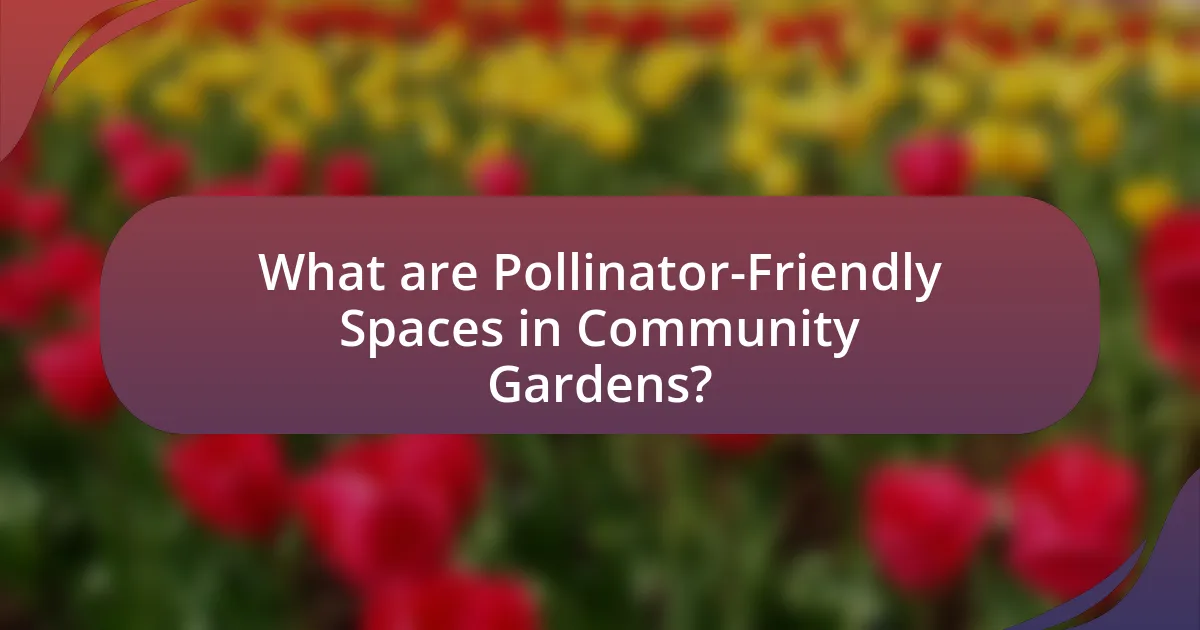
What are Pollinator-Friendly Spaces in Community Gardens?
Pollinator-friendly spaces in community gardens are designated areas that provide habitats and resources for pollinators such as bees, butterflies, and other insects. These spaces typically include a variety of native flowering plants that bloom at different times throughout the growing season, ensuring a continuous food source. Research indicates that gardens with diverse plant species can support higher populations of pollinators, enhancing biodiversity and ecosystem health. Additionally, features like water sources, nesting sites, and minimal pesticide use further contribute to the well-being of pollinator populations, making community gardens vital for local environmental sustainability.
Why are pollinators important for community gardens?
Pollinators are crucial for community gardens because they enhance plant reproduction and increase crop yields. By transferring pollen from one flower to another, pollinators such as bees, butterflies, and other insects facilitate the fertilization process, which is essential for the production of fruits, seeds, and vegetables. Research indicates that gardens with diverse pollinator populations can see up to a 50% increase in fruit set compared to those without. This not only boosts the productivity of the garden but also contributes to biodiversity, creating a healthier ecosystem.
What roles do different pollinators play in the ecosystem?
Different pollinators, such as bees, butterflies, birds, and bats, play crucial roles in the ecosystem by facilitating the reproduction of flowering plants through the transfer of pollen. This process enhances plant diversity and productivity, which in turn supports food webs and habitats for various organisms. For example, bees are responsible for pollinating approximately 70 of the top 100 crop species, which account for about 90% of the world’s food supply. Additionally, butterflies contribute to the pollination of many wildflowers, promoting biodiversity. Birds, like hummingbirds, also assist in pollination, particularly in tropical ecosystems, while bats are vital for pollinating night-blooming plants. The decline of these pollinators can lead to reduced plant reproduction, affecting entire ecosystems and food sources for other species.
How do pollinators contribute to food production in gardens?
Pollinators significantly enhance food production in gardens by facilitating the process of plant reproduction through pollination. This process increases the yield and quality of fruits, vegetables, and flowers, as approximately 75% of the world’s flowering plants depend on animal pollinators, including bees, butterflies, and birds. Research indicates that gardens with diverse pollinator populations can produce up to 50% more fruit compared to those without such biodiversity, demonstrating the critical role pollinators play in ensuring successful crop development and overall garden productivity.
What characteristics define a pollinator-friendly space?
A pollinator-friendly space is characterized by diverse plant species that provide nectar and pollen throughout the growing season. This diversity supports various pollinators, including bees, butterflies, and hummingbirds, which require different types of flowers for sustenance. Additionally, such spaces should include native plants, as they are better adapted to local ecosystems and attract native pollinators more effectively.
Moreover, pollinator-friendly spaces should avoid the use of pesticides and herbicides, which can harm pollinator populations. Incorporating features like water sources, shelter, and nesting sites further enhances the habitat for pollinators. Research indicates that gardens with a variety of flowering plants can increase pollinator visitation rates by up to 50%, demonstrating the importance of these characteristics in supporting pollinator health and biodiversity.
What types of plants attract pollinators effectively?
Native flowering plants attract pollinators effectively. These plants, such as coneflowers, milkweed, and black-eyed Susans, provide essential nectar and pollen for bees, butterflies, and other pollinators. Research indicates that native plants are more beneficial for local pollinator populations because they have co-evolved with these species, offering the specific resources they need for survival. For example, a study published in the journal “Ecological Applications” found that gardens with a higher diversity of native plants supported significantly more pollinator species compared to those with non-native plants.
How can garden layout enhance pollinator accessibility?
Garden layout can enhance pollinator accessibility by incorporating diverse plant species, creating continuous bloom periods, and ensuring easy navigation for pollinators. A diverse array of flowering plants attracts various pollinator species, as different pollinators are drawn to specific flowers. For instance, research indicates that gardens with at least 10 different flowering species can support a wider range of pollinators, increasing overall biodiversity. Continuous bloom periods throughout the growing season provide a consistent food source, which is crucial for pollinator survival. Additionally, designing pathways and open spaces allows pollinators to move freely between plants without obstacles, further facilitating their access to nectar and pollen.
What challenges do pollinators face in urban environments?
Pollinators face several challenges in urban environments, primarily due to habitat loss, pollution, and limited food sources. Urbanization often leads to the destruction of natural habitats, reducing the availability of nesting sites and flowering plants essential for pollinators. Additionally, pollution from vehicles and industrial activities can harm pollinator health and disrupt their foraging behavior. Studies indicate that urban areas typically have fewer diverse plant species, which limits the food options for pollinators, ultimately affecting their populations and the ecosystem services they provide.
How does habitat loss impact pollinator populations?
Habitat loss significantly reduces pollinator populations by eliminating their food sources and nesting sites. When natural habitats are destroyed for agriculture, urban development, or other human activities, the availability of flowering plants and suitable environments for pollinators like bees and butterflies diminishes. Research indicates that areas with high habitat fragmentation can lead to a decline in pollinator diversity and abundance, as seen in studies conducted by the University of Reading, which found that habitat loss correlates with a 30% decrease in pollinator species richness. This decline negatively affects plant reproduction and ecosystem health, highlighting the critical need for preserving and creating pollinator-friendly spaces.
What role do pesticides play in pollinator decline?
Pesticides significantly contribute to pollinator decline by causing direct harm to these essential species. Studies have shown that neonicotinoids, a class of pesticides, can impair the foraging behavior and reproductive success of bees, leading to population reductions. For instance, research published in the journal “Nature” by Goulson et al. (2015) indicates that exposure to neonicotinoids can reduce bee colony growth and survival rates. Additionally, pesticides can disrupt the broader ecosystem, affecting the availability of food sources for pollinators, further exacerbating their decline.
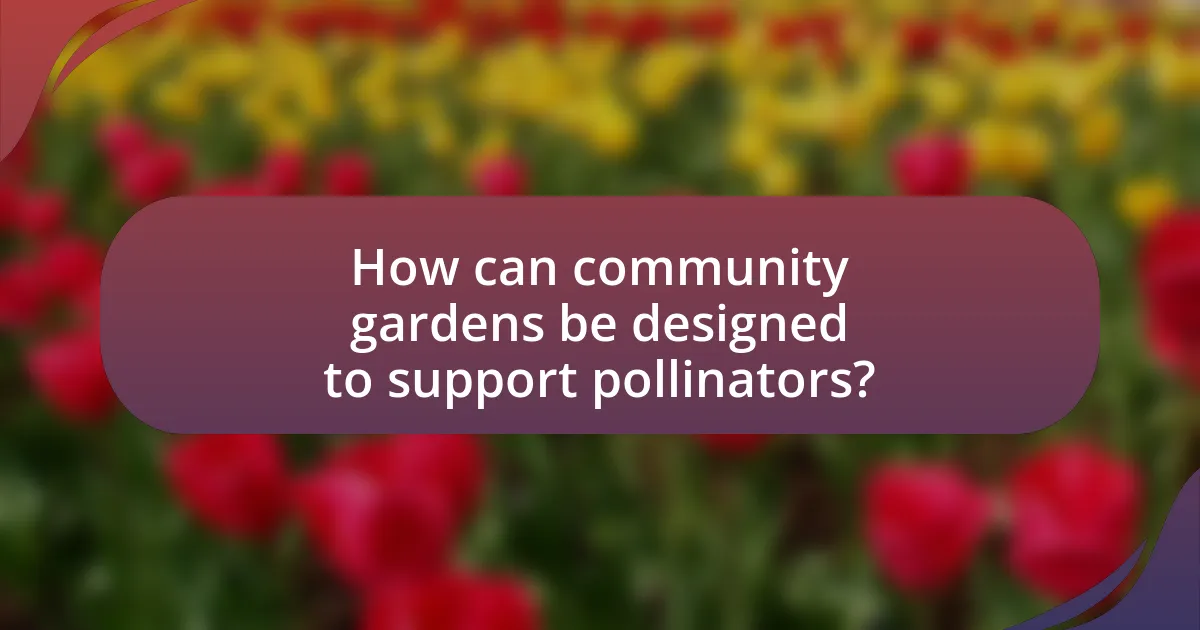
How can community gardens be designed to support pollinators?
Community gardens can be designed to support pollinators by incorporating a diverse range of native flowering plants, providing habitats, and minimizing pesticide use. Native plants are essential as they offer the specific nectar and pollen that local pollinators, such as bees and butterflies, require for survival. Research indicates that gardens with at least 30% native plants can significantly increase pollinator diversity and abundance. Additionally, creating habitats such as bee hotels, brush piles, and undisturbed soil areas can provide nesting sites for various pollinator species. Furthermore, reducing or eliminating pesticide use helps protect pollinators from harmful chemicals, which can lead to population declines. These strategies collectively enhance the ecological value of community gardens, making them vital resources for pollinator conservation.
What design principles should be considered for pollinator-friendly gardens?
Pollinator-friendly gardens should incorporate diverse plant species, native plants, and continuous blooming periods. Diverse plant species attract a variety of pollinators, while native plants provide the best resources for local species. Continuous blooming ensures that food sources are available throughout the growing season, supporting pollinator populations. Research indicates that gardens with a mix of flowering plants can increase pollinator visitation rates by up to 50%, demonstrating the effectiveness of these design principles in enhancing pollinator habitats.
How can native plants be incorporated into garden designs?
Native plants can be incorporated into garden designs by selecting species that are well-adapted to the local environment and arranging them in a way that promotes biodiversity and supports pollinators. For instance, using a mix of flowering native plants that bloom at different times throughout the growing season ensures a continuous food source for pollinators. Research indicates that gardens with diverse native plant species can attract up to 50% more pollinators compared to those with non-native plants. Additionally, grouping plants in clusters rather than single specimens can enhance visibility and accessibility for pollinators, further increasing their effectiveness in supporting local ecosystems.
What features can provide shelter and nesting sites for pollinators?
Natural features such as native plants, undisturbed soil, and brush piles provide essential shelter and nesting sites for pollinators. Native plants offer food sources and habitat, while undisturbed soil allows ground-nesting bees to create their nests. Additionally, brush piles serve as refuge and nesting areas for various pollinators, including solitary bees and butterflies. Research indicates that gardens incorporating these features can significantly enhance pollinator diversity and abundance, thereby supporting ecosystem health.
How can community involvement enhance pollinator-friendly efforts?
Community involvement can enhance pollinator-friendly efforts by fostering collaboration among local residents to create and maintain habitats that support pollinators. Engaging community members in planting native flowers, establishing bee hotels, and organizing educational workshops increases awareness about the importance of pollinators and encourages sustainable practices. Research indicates that community gardens with active participation can significantly improve biodiversity; for instance, a study published in the journal “Ecological Applications” found that community-managed gardens had 30% more pollinator species compared to those without community involvement. This collective action not only boosts pollinator populations but also strengthens community ties and promotes environmental stewardship.
What educational programs can raise awareness about pollinators?
Educational programs that can raise awareness about pollinators include community workshops, school curricula focused on biodiversity, and citizen science initiatives. Community workshops often involve hands-on activities like planting pollinator gardens, which directly engage participants and educate them about the importance of pollinators in ecosystems. School curricula that incorporate lessons on pollination and the role of bees and other pollinators in food production can foster early awareness among students. Citizen science initiatives, such as monitoring local pollinator populations, allow individuals to contribute to data collection while learning about pollinator habitats and behaviors. These programs are effective as they provide practical knowledge and encourage community involvement, which is essential for fostering a culture of conservation.
How can volunteers contribute to maintaining pollinator habitats?
Volunteers can contribute to maintaining pollinator habitats by participating in habitat restoration activities, such as planting native flowering plants that provide food for pollinators. Research indicates that native plants are crucial for supporting local pollinator populations, as they offer the specific nutrients and resources that non-native plants often lack. Additionally, volunteers can help with habitat maintenance tasks like weeding, mulching, and watering, which ensure that these plants thrive and continue to attract pollinators. Engaging in educational outreach within the community also empowers volunteers to raise awareness about the importance of pollinators and the need for habitat preservation, further enhancing the effectiveness of their contributions.
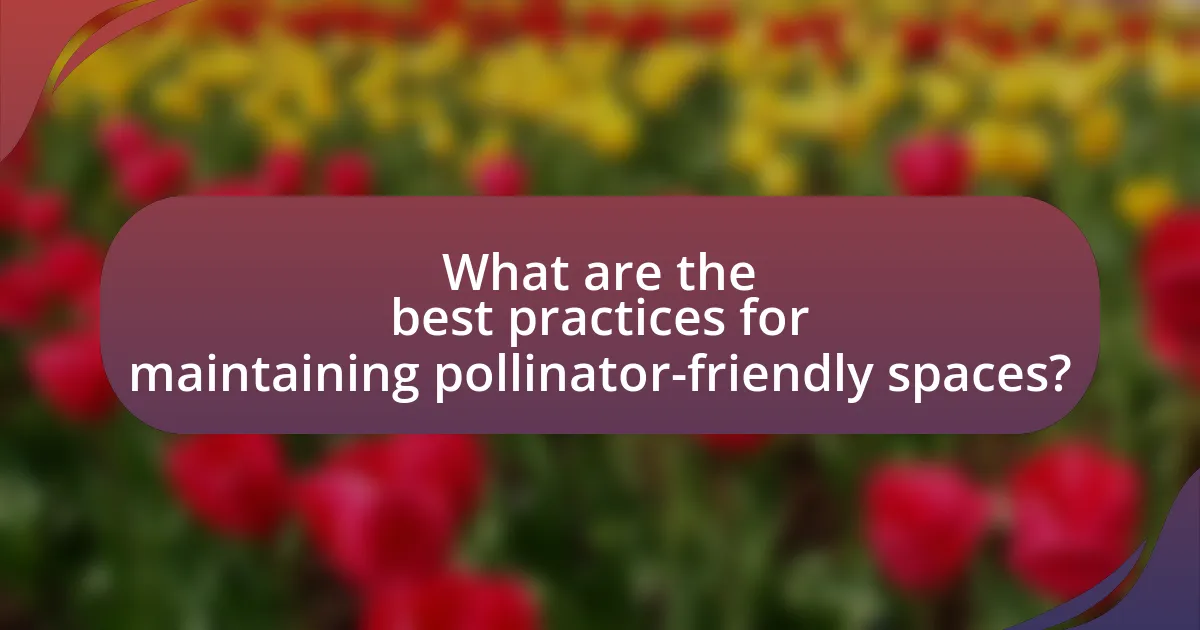
What are the best practices for maintaining pollinator-friendly spaces?
To maintain pollinator-friendly spaces, it is essential to plant a diverse range of native flowering plants that bloom at different times throughout the growing season. This diversity ensures a continuous food source for pollinators such as bees, butterflies, and other beneficial insects. Research indicates that native plants are more attractive to local pollinators and support higher populations compared to non-native species. Additionally, avoiding the use of pesticides and herbicides is crucial, as these chemicals can harm pollinators and disrupt their habitats. Implementing practices such as leaving some areas of the garden undisturbed, providing water sources, and creating nesting sites further enhances the environment for pollinators. Studies show that gardens with these features significantly increase pollinator visitation rates and overall biodiversity.
How can gardeners ensure a continuous bloom for pollinators?
Gardeners can ensure a continuous bloom for pollinators by selecting a diverse range of flowering plants that bloom at different times throughout the growing season. This strategy allows for a steady supply of nectar and pollen, which is essential for pollinator health. For instance, planting early bloomers like crocuses and snowdrops in spring, followed by summer flowers such as coneflowers and sunflowers, and including late bloomers like asters and goldenrods in the fall, creates a timeline of floral availability. Research indicates that gardens with a variety of plants that flower at different times can support a higher diversity of pollinators, as noted in studies by the Xerces Society, which emphasizes the importance of plant diversity in sustaining pollinator populations.
What seasonal planting strategies are most effective?
The most effective seasonal planting strategies for creating pollinator-friendly spaces in community gardens include planting a diverse array of native flowering plants that bloom at different times throughout the growing season. This approach ensures a continuous food source for pollinators, such as bees and butterflies, which are crucial for ecosystem health. Research indicates that gardens with a variety of plants that flower in spring, summer, and fall attract more pollinators compared to those with limited bloom times. For example, studies have shown that native plants like coneflowers, milkweed, and asters not only support local pollinator populations but also enhance biodiversity and resilience in garden ecosystems.
How can gardeners manage invasive species without harming pollinators?
Gardeners can manage invasive species without harming pollinators by employing targeted removal methods and promoting native plants. Targeted removal includes hand-pulling or using tools to extract invasive species, which minimizes disturbance to the surrounding ecosystem and protects pollinator habitats. Promoting native plants creates a supportive environment for pollinators, as these plants are adapted to local conditions and provide essential resources. Research indicates that native plants can increase pollinator diversity and abundance, thereby enhancing the overall health of the garden ecosystem.
What resources are available for creating and maintaining these spaces?
Resources available for creating and maintaining pollinator-friendly spaces in community gardens include native plant nurseries, educational workshops, and online databases. Native plant nurseries provide a variety of local flora that supports pollinator species, ensuring the right plants are selected for the local ecosystem. Educational workshops, often hosted by local agricultural extensions or conservation organizations, offer guidance on best practices for planting and maintaining these spaces. Online databases, such as the Pollinator Partnership’s Plant List, provide detailed information on suitable plants and their benefits to pollinators, reinforcing the importance of biodiversity in garden design.
What local organizations support pollinator-friendly gardening initiatives?
Local organizations that support pollinator-friendly gardening initiatives include the Xerces Society for Invertebrate Conservation, which promotes the conservation of pollinators through habitat restoration and education. Additionally, local chapters of Master Gardeners often provide resources and workshops focused on pollinator-friendly practices. Community gardening groups, such as the American Community Gardening Association, also advocate for pollinator habitats within urban gardens. These organizations contribute to the awareness and implementation of practices that benefit pollinators, thereby enhancing biodiversity and ecosystem health.
How can online platforms provide guidance and community support?
Online platforms can provide guidance and community support by offering resources, forums, and interactive tools tailored to creating pollinator-friendly spaces in community gardens. These platforms can host educational content, such as articles and videos, that detail best practices for planting native species and maintaining habitats that attract pollinators. Additionally, community forums allow users to share experiences, ask questions, and receive feedback from fellow gardeners, fostering a sense of belonging and collaboration. Research indicates that online communities can enhance knowledge sharing and increase engagement in environmental initiatives, as seen in studies like “The Role of Online Communities in Environmental Education” by Smith and Jones, which highlights the effectiveness of digital platforms in promoting sustainable practices.
What practical tips can help gardeners create successful pollinator-friendly spaces?
To create successful pollinator-friendly spaces, gardeners should plant a diverse range of native flowering plants that bloom at different times throughout the growing season. This diversity ensures that pollinators have a continuous food source. Research indicates that native plants are more beneficial for local pollinators, as they have co-evolved with them, providing the necessary nectar and pollen. Additionally, gardeners should avoid using pesticides, as these chemicals can harm pollinators; studies show that neonicotinoids, a common class of pesticides, are particularly detrimental to bee populations. Providing habitats such as bee hotels, native grasses, and undisturbed areas can also support pollinator nesting and shelter needs. Implementing these strategies can significantly enhance the health and diversity of pollinator populations in community gardens.
